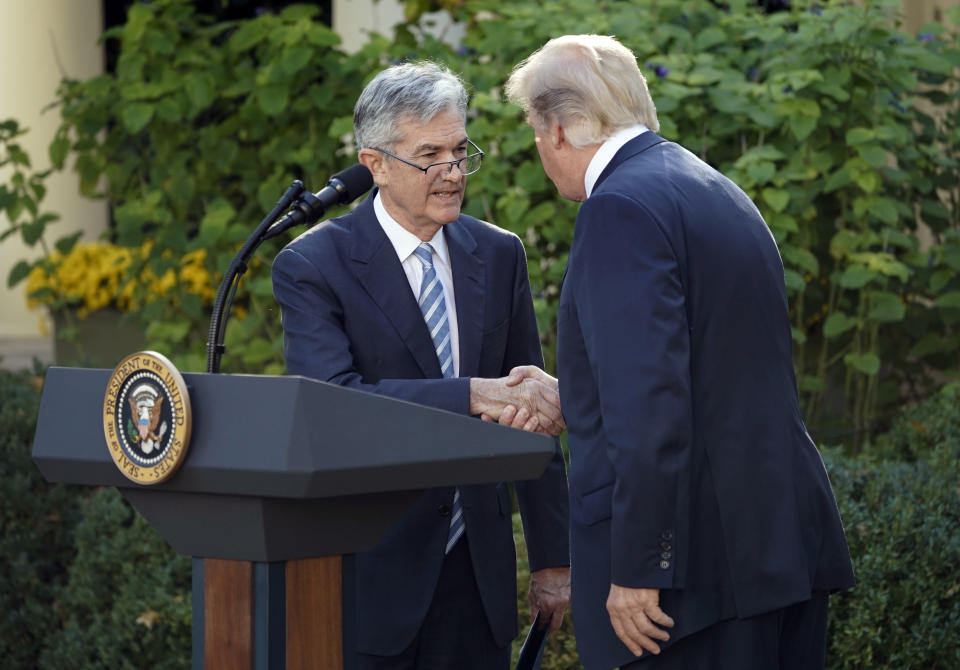How a Trump reelection could reshape Fed policy
Should he win a second term, President Donald Trump may have a golden opportunity to reshape the orientation of a Federal Reserve whose policies he’s repeatedly maligned.
Currently, Trump’s two recent nominees to the central bank, Herman Cain and Stephen Moore, are imperiled by growing resistance from within the president’s own party. On Friday, Cain’s short-lived bid appeared all but finished after four Republican Senators publicly voiced opposition. Meanwhile, Moore’s candidacy is also facing an uphill battle.
Fed leadership positions must be confirmed by the Senate, where the GOP holds a slim majority.
While Wall Street doesn’t believe any of Trump’s current nominees will alter the Fed’s consensus-driven deliberations, the president has reportedly confided to aides that “I want my own guys” at the Fed — a nod to his desire for partisans who’ll boost his agenda rather than engage in independent, policy-based analysis.
With crises flaring on a daily basis, and an approval rating below 50%, it’s very much an open question whether voters will send Trump back to the Oval Office in 2020.
That said, the stakes will be amplified if the president indeed prevails, and moves to install loyalists in Fed leadership positions, as a report in Thursday’s Wall Street Journal suggested he might. Three key governing slots will be up for grabs in the year the next president takes the oath of office in January 2021, which includes the Fed chairmanship.
“Central bank independence is even more important in an era of quantitative policy,” said Paul Donovan, UBS’s global chief economist. Donovan called that policy “useful but dangerous” in a note on Friday.
“Economists are best placed to judge when it should and should not be used,” he added. “Financial markets should pay attention to who should be nominated for the two vacant Fed positions.”
Indeed, Trump’s predisposition to loyalists has become a worry for a growing number of market participants that have defended the time-honored tradition of a central bank unencumbered by politics.
Stacking the Fed?
To be certain, the point is moot if Trump is ousted in November 2020. Although the president’s approval rating ticked higher in a Gallup poll released on Friday, preliminary readings of the general election show him trailing most of the leading contenders in an increasingly crowded Democratic fields.
However, anything can happen between now and the general election. And a second Trump term means the president stands a chance of re-orienting the Fed’s Open Market Committee (FOMC), the powerful body that sets interest rates and determines policy, with picks who are more supportive of his agenda.
Trump has publicly lambasted Fed Chairman Jerome Powell, mostly because of the Fed’s campaign to tighten monetary policy with rate hikes. The central bank is currently on pause as it assesses the current global growth soft patch.

The more salient issue is that the four-year terms of both Powell and Vice Chair Richard Clarida will expire in 2022. It gives the president the opportunity to fill at least 2 crucial vacancies that can promote Trump’s economic initiatives until the end of his theoretical 2nd term.
“If President Trump were to be re-elected and even if all current governors serve out their full terms as governor, the President will have at least one more opportunity to nominate a new member to the board (to replace Clarida), if the president so chooses,” said Ken Matheny, executive director, Macroeconomic Advisers by IHS Markit on Thursday.
Noting that all three leadership positions at the Fed’s board will turn over within a year of the start of the next presidential term, Matheny added that the next president “might have substantial ability to influence the composition of the board, and by extension, policy decisions, with the obvious proviso that all nominations are subject to Senate confirmation.”
‘Nearly wholesale changes to the board’
With Fed policy already politicized by the president’s vocal criticism —Trump reportedly mulled dumping Powell late last year — Matheny added that “it is conceivable that all three of the individuals currently in those positions, if they are not renominated, could resign from the board...or will be termed out” between October 2021 and February 2022.
“Clearly there is an opportunity for nearly wholesale changes to the board between now and 2022,” the analyst said.
Amid Trump’s desire for loose money to bolster the economy, the Fed’s decisions would be scrutinized for their political impact, thus “lead[ing] markets to worry about the independence of monetary policy,” said Michael Gapen, an economist at Barclays.
Indeed, Cain and Moore were reportedly selected by Trump because of their unapologetic support of his calls for another rate cut. Both men’s current alignment with Trump on monetary policy has contradicted their previously held positions on monetary policy.
“In our view, the experience of each candidate does not seem to be the main reason the Trump administration is considering their nominations,” he added.
Should Trump use his 2nd term to nominate candidates of a similar vein, it’s “likely to raise questions about the Fed’s independence and about politicization of the US central bank,” Barclay’s Moore wrote.
Javier David is an editor for Yahoo Finance. Read more:
Jamie Dimon defends capitalism, says US socialism would be 'a disaster'
America's CFOs expect a downturn, but not a recession: Study
Why the yield curve's recession warning could be wrong this time
Gold demand supported as central banks sour on dollar-denominated debt
Follow Javier on Twitter: @TeflonGeek
